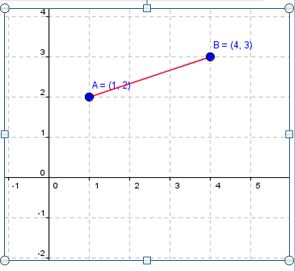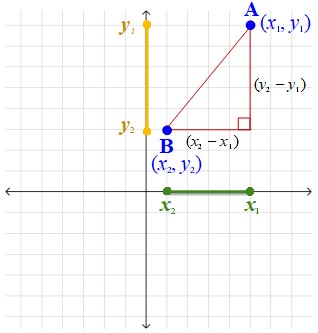Learn
Segment Addition and Distance
Segment addition is really a simple concept. Basically, the length of a line segment is the sum of all of the smaller segments joined together to form it. Formally, this concept is called the segment addition or ruler postulate.

Segment Addition
If I ask you to determine how far it is from House A to House C, you can easily see that you need to add the distance from House A to House B to the distance from House B to House C.
So, the distance from House A to House C is: distance House A to House C = 5 miles + 11 miles distance House A to House C = 16 miles
Segment Notation
Of course we get tired of saying (not to mention writing) “the distance between House A and House C.” Instead we use symbols. When we name a line segment with endpoints A and C using symbols, we write AC. But if we want to denote the length of the line segment, or the distance between points A and C, we simply write AC with a line over the letters.

Suppose that I tell you that point B is between A and C. Note, that does NOT mean that B is exactly in the middle of points A and C, just somewhere between. Regardless of the position of B, as long as it is between A and C then we can refer to the distance between points A and C using symbols in this way: AC = AB + BC Remember, it doesn’t matter where point B lies along AC. As long as B is between A and C the above equation is correct.

Segment Notation Example
Now, if we include actual lengths, measurements, on our picture, we can determine the measure of AC using our same equation.

AC = AB + BC
AC = ? + ?
Add the length of the two segments together.
AC = 7 feet + 13 feet
So, AC = 20 feet
Postulate 1-1 The Ruler Postulate
The points on any line can be paired with real numbers so that given any two points P and Q on the line, P corresponds to zero, and Q corresponds to a positive 1.

Postulate 1-2 Segment Addition Postulate
If R is between P and Q, then PR + RQ = PQ.
If PR + RQ = PQ, then R is between P and Q.
Definition of Betweeness
Segments can be defined by using the idea of betweenness of points. In the figure, Point B is between A and C. For B to be between A and C, all three points must be collinear and B must lie on AC.
Line segment AB, consists of points A and B and all points between A and B. The measure of line segment AB, written AB, is the distance between A and B. Thus, the measure of a line segment is the same as the distance between its two endpoints.
Distance
The measure of distance is always a positive value. If you were asked how far you had walked you would not say -5 miles .... you would say 5 miles. The direction in which you traveled made no difference to the actual distance.
Difference of the Coordinates
The distance between two points on a number line is the absolute value of the difference of the coordinates.

BC = | B - C |
Use the coordinate of B and C
BC = |-2 - 1|
BC = 3
The distance between two points on a number line can also be found by counting the distance between the two points. Remember the distance is always positive. It is three whole steps from B to C.
AB = 1.5
BA = 1.5
Count the spaces between A and B
CB = 3
BC = 3
Count the spaces between B and C
BD = 5
DB = 5
Count the spaces between B and D
It does not matter if you start with B or D to find the distance.
Distance Formula
Special Notation for Points on a Coordinate Plane
We use special notation to distinguish between two points on a coordinate plane. One point we will label (x1, y1) and the other point will be labeled (x2 , y2). It does not matter how you label either point. For our example I will label (1, 2) as (x1, y11) and (4, 3) as (x2 , y2). The rest is just placing the values into the correct location of the formula.

Derive the Distance Formula
You can use the Pythagorean Theorem to derive the formula to find the distance between any two points A and B on a coordinate plane.

- To begin, label the coordinates of point A, (x1, y1) and the coordinates of point B, (x2, y2).
- Construct right angle using a vertical line segment that passes through point A and a horizontal line segment that passes through point B.
- Construct a line segment between points A and B. The figure formed is a right triangle. Segment AB is the hypotenuse and the other two sides are the legs.
- Subtract the x-values to find the length of the horizontal leg.
- Subtract the y-values to find the length of the vertical leg.
- Use the Pythagorean Theorem, c2 = a2 + b2, to find the distance between points A and B which is denoted by AB.
- Let a be the length of the horizontal leg which is x2 − x1.
- Let b be the length of the vertical leg which is y2 − y1.
- Let c is the length of segment AB which is denoted by AB.
- Substitute in x2 − x1 for a, y2 − y1 for b, and AB for c.
AB2 =
Take the square root of both sides.
Simplify

=

Now find the lengths of the legs of the right triangle.
Formula
The formula for finding the distance between two points on a coordinate plane is given below. We’ll talk more about where this formula comes from later.

Distance Formula Example #1
Open Finding the Distance Between Two Points, A and B, on a Coordinate Plane in a new tab
Distance Formula Example #2
Distance Formula Example #3
Find the distance between A(5, –1) and B(3, 7).
Step 1: Label the coordinates of point A, (x1, y1) and the coordinates of point B, (x2, y2).
A(5,−1), B(3,7)
Step 2: Write the distance formula.
Step 3: Substitute in the values:
- 3 for x2,
- 5 for x1,
- 7 for y2, and
- −1 for y1.
Step 4: Use the order of operations to simply what's under the radical symbol.

Change the double signs "− −" to a plus sign.

Simplify the first set of parentheses. (3 − 5) = −2.

Simplify the second set of parentheses. (7 + 1) = 8.

Simplify the 1st exponent. (−2)2 = 4.

Simplify the 2nd exponent. 82 = 64

Add 4 + 64

Step 5: Write  in simplified form.
in simplified form.
To write in simplified form, you must rewrite  as a product of a perfect square and a number.
as a product of a perfect square and a number.
The only way to rewrite  a product of a perfect square and a number is
a product of a perfect square and a number is  ×
×  .
.
AB = 
Substitute in  ×
×  for
for 
AB =  ×
× 
Take the square root of 
AB = 2 × 
The distance between points A(5, −1) and B(3, 7) is:
AB =
Segment and Distance
Although football was used in the Introduction to discuss distance, a football field is not a good example of a number line. You could count by 10s on the number line but because 0 is not in the middle with negatives on the left and positives on the right, absolute value of the difference doesn't work.